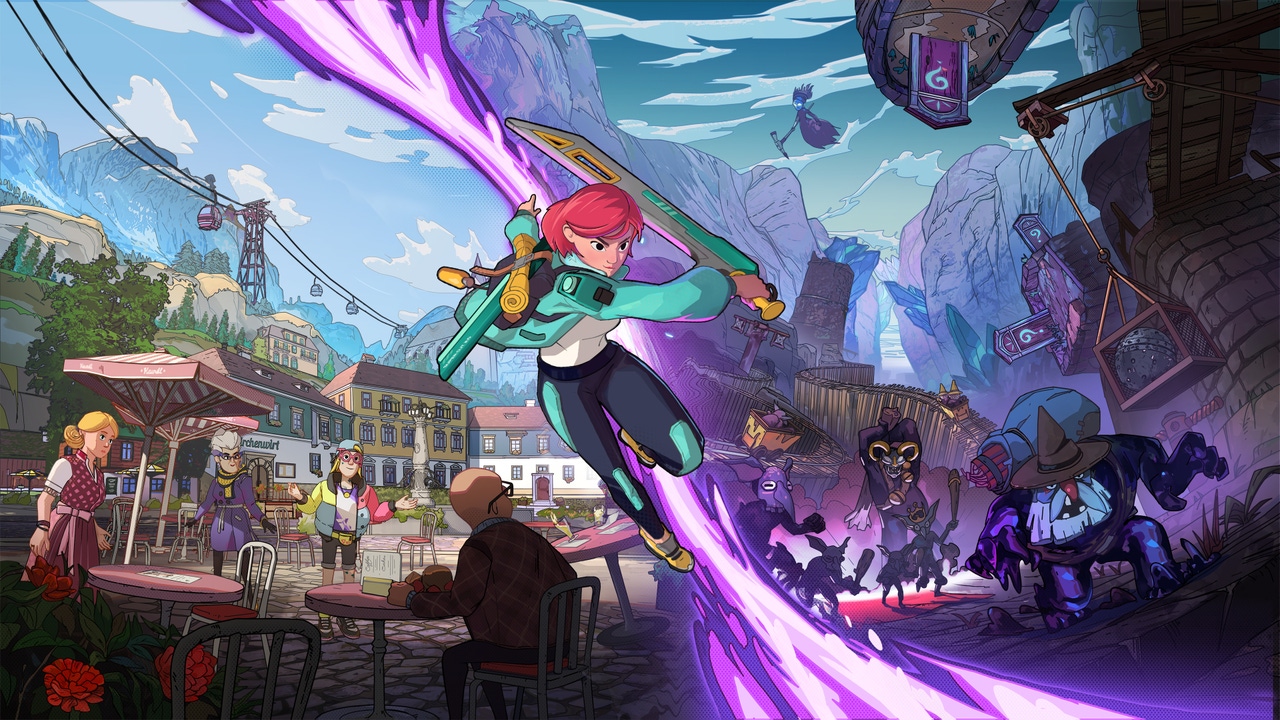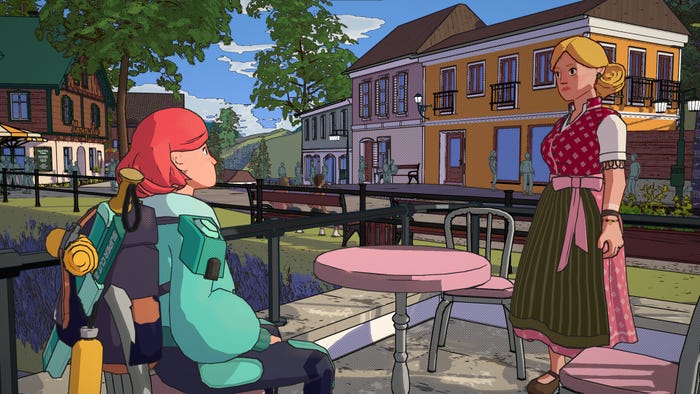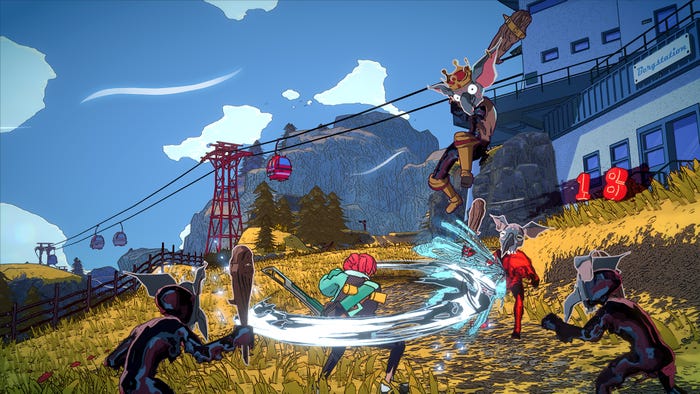Trending
Opinion: How will Project 2025 impact game developers?
The Heritage Foundation's manifesto for the possible next administration could do great harm to many, including large portions of the game development community.
Vacation's where I want to be.

Dungeons of Hinterberg is an action adventure game about a vacation gone—right? Microbird Games' debut title (published by Curve Games) defies the usual framework for monster hunting narratives. Instead of a world threatened by darkness, player character Luisa ventures to the town of Hinterberg which is threatened by—tourists, Luisa among them.
The town has drawn an international array of visitors thanks to the recent appearance of magical dungeons that have now become a monster-laden safari zone. The high-level game loop leans into the vacation theming, with Luisa waking up each morning, picking a region to visit and fight through, returning to Hinterberg to shop and socialize, then head to bed.
The end result is a game that strikes a careful balance between "relaxing" and dynamic action. To achieve that, Microbird cofounders Regina Reisinger and Philipp Seifried told Game Developer that they aimed to make a game that can feel like a "temporary home"—the kind that can take players on a digital vacation of their own.
Seifried and Reisinger said they began work on what would become Dungeons of Hinterberg during the height of the COVID-19 pandemic in 2020. They were big fans of how the Persona games use a day/night cycle to let players explore urban Japan, and observed that no one had used that framework for a game set in Europe.
Switzerland's game development scene is still relatively small, and few developers from the region have explored the aesthetics of the Autrian countryside—most famously the Alps. Hinterberg is inspired by the town of Helstadt, but the pair said they took inspiration from many towns when they ventured out of Vienna on research trips.
Taking those trips helped them think about how even though they were Austrian citizens, they weren't all that different than the international travelers passing through after seeing videos of the Alps on social media. "We both grew up more in the city," Reisinger said. "We're familiar with these small towns but we're also kind of outsiders...on the one hand, it's your home country and you know the landscapes, but at the same time you are a bit of a tourist if you come to such a small village."

Image via Microbird Games/Curve Games.
Capturing that sensation led to an interesting challenge for designing Hinterberg itself: the town had to feel like a small Austrian village, but it also needed the aesthetics of a tourist trap to dial in that "vacation" feeling.
The sensation of being on "vacation," or treating games as a temporary home, seems to be close to Seifried's heart. "If you go on vacation, there's a new place you get to explore. You have your home base there—usually your hotel—and you have your daily routine. That's something that's in [games], right?"
This concept adds another layer of fun to the magic abilities players unlock when they visit different zones. In each hub area out in the world, players get access to a pair of magical abilities, designed to uniquely interact with puzzles in that region. Trekking up and down the hills to find different dungeons becomes akin to a small hike, with magically-solved puzzles having the feel of tourist activities instead of world-altering power.
This peaks when players visit the top of the mountains themselves in an area called Kolmstein. In this snowy region, players get access to a snowboarding ability that lets them shred the slopes and grind rails. Using the snowboarding power outside of combat or puzzles shows how Microbird captured the sensation of mindlessly gliding over the hills. It's one of many ways where Dungeons of Hinterberg rewards idle play over relentless progression.
Asking Reisinger and Seifried about the game's social system—where players choose an NPC to spend time with each evening to boost stats and unlock abilities—led to a conversation about the nuts and bolts of developing Dungeons of Hinterberg. I'd asked them how they made the system manageable despite the small team size.
"We didn't," was the sheepish answer I got back. Seifried admitted it was "four hard years" for himself and Reisinger, the only two members of the studio who would work any overtime. "There's probably not a lot of teams of our size that would tackle a project this big and ambitious, but if you do that you reap a lot of benefits just from the fact that... in order to do something like this, everyone must wear several hats."

Image via Microbird Games/Curve Games.
Seifried wrote the game's story, was the lead programmer, and designed the engine used for cutscenes. That meant when he was penning dialogue sequences, he could think about what the cutscene tool was capable of displaying, and also what he could improve in said tool when he got back to work on it.
Likewise Reisinger also pulled double duty with the level designers, and knew how to block out spaces to make her artwork more efficient. "Being a small team with everybody being trained in more than one discipline gives us a lot of opportunity to figure out how to do something big as this without tons of meetings, iterations, and friction," said Seifried.
You'll fund some of that swiss-army-utilitarianism in Reisinger's art as well. The game jumps camera perspectives and gameplay styles to enable puzzles, high-speed snowboarding, combat, and exploration. She was already inspired by the clear lines and flat colors of French and European comics, but also took inspiration from Sony Animation's Spider-Verse films.
Most assets were built in 3D without intensive concept art, and don't require tons of texture work—not every asset requires normal maps, Seifried added. This art style also makes it easy to bring in third-party assets.
Reisinger summed it up like so: "We built stuff to be as usable in different contexts as possible."
The pair seemed ready to take a vacation of their own after Dungeons of Hinterberg ships, both of them saying they'd love to crunch "far less" on their next game.
But Seifried did note that making a vacation-themed game helped make the crunch tolerable. "If you're going to work overtime on your project, try and find a project where you work on a vacation [setting]," he joked. "That place, over time, will feel a lot more pleasant than if you're doing a survival horror game."
Update: This story previously referred to the game and its developers as being Swiss. The game was made and is set in Austria.
You May Also Like